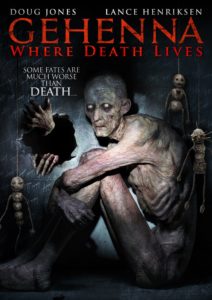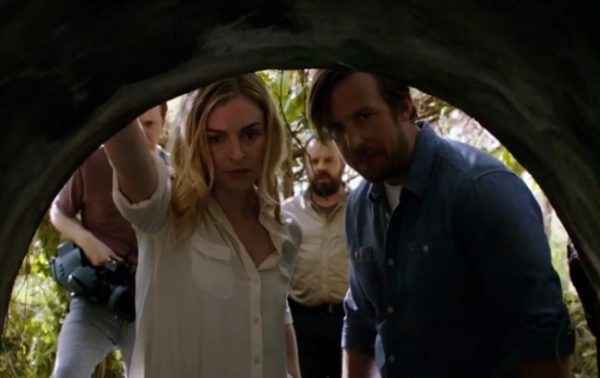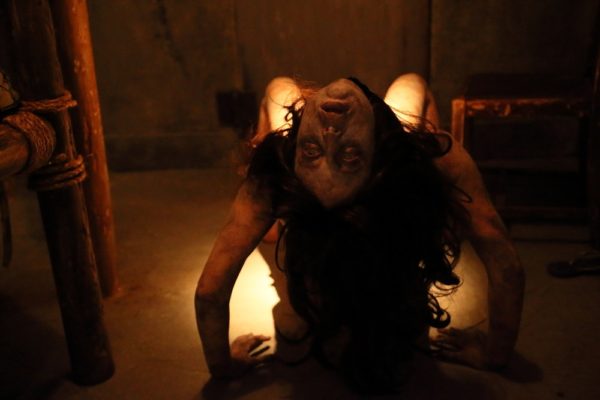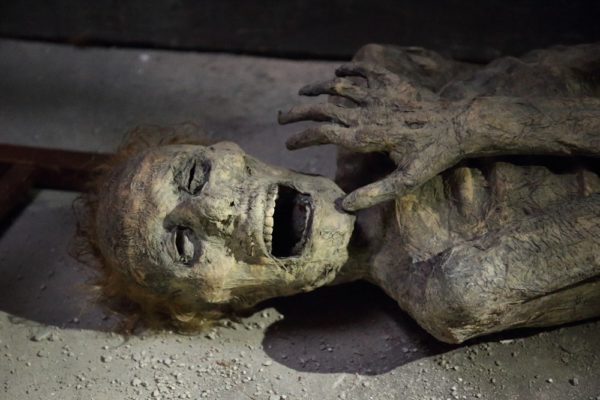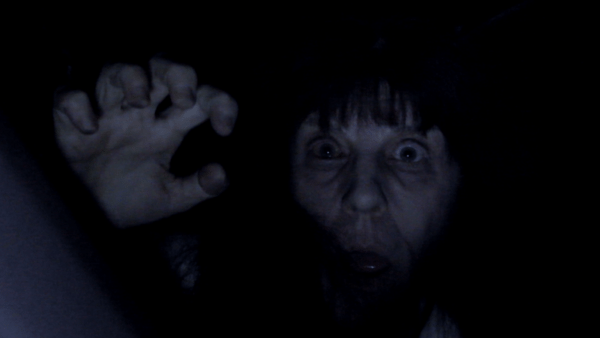Even by the miserable standards of other Folkloric characters, Krampus has a particularly wretched cinematic legacy. On second thought, ‘’cinematic’’ might not be the most appropriate term for his outings. After all, whilst the festive menace has certainly appeared in his fair share of films, he’s only graced multiplex screens on one occasion. This was for Michael Dougherty’s supremely enjoyable, 2015 Horror-Comedy, Krampus, which can be distinguished as ‘’the only proper one’’.
Horror
Spooky, scary, mostly bad.
Review | For the Love of the Boogeyman: 40 Years of Halloween
Although it clearly comes from a place of love, For the Love of the Boogeyman is a shallow documentary that has little new to offer.
Support Us!
This Film:
Editing Software: http://geni.us/GxgvNAv
Amazon: http://geni.us/Pch7G3M
These links are affiliate links – by clicking them we will receive a small commission at no cost to you.
Ask any genre enthusiast to break down the success of Halloween and they are all-but-guaranteed to have a full-blown thesis prepared for such an occasion. With notes by their side, they will readily launch into an impassioned sermon; expounding upon the film’s merit as a cinematic milestone and waxing poetic about everything from its economic use of lighting, to its meticulous framing and atmospheric score.
Indeed, there’s no shortage of people lining up to feleate Carpenter’s iconic masterwork. I myself wrote a particularly conceited essay about it at University, despite being unable to formulate a remotely compelling argument. I just ended up reiterating what countless others had already articulated before me and ultimately failed to say anything more insightful than ”that Michael Myers is well creepy!’
Unfortunately, a similar critique can be leveled at For the Love of the Boogeyman, a sycophantic documentary that tellingly markets itself as being made ‘by fans and for the fans”. Translation: ”it’s a fawning circle-jerk, with little-to-no substance and a startling lack of fresh perspective”. So in that sense, it is strikingly reminiscent of my flimsy uni assignment, only much longer and with less uses of the word ”thus”.
You see, there’s no illuminating analysis to speak of here, just people repeating variations on the phrase ”first and last word in genre film-making”. Which would be fine if you were doing a quick review or perhaps a blog post. But there’s not enough meat on those bones to justify a paltry video-essay, never mind a 40 minute project comprised of dozens of interviewees!
What’s worse is that, over the course of the piece, alternate readings are never even hinted at, giving it a very narrow view. This is partly because the talking heads are all interchangeable, with comparable interests and matching opinions. Consequently, they all approach the material from the same, bland position. There’s no contrast to the discussion here. No variety. No back and forth. Just people rabbiting on in circles about how much they love a 40 year-old movie.
Given that none of the presenters actually worked on Halloween, you would think that they’d at least have interesting takes to make their commentary worth listening to. But they don’t! They just offer banal praise of every facet of the film-making, like they’re dutifully ticking off all the Oscar categories or something.
”The acting is great. And the directing is great. And the cinematography is great. And the production design is great. And the music is great. And the best animated film is great!’ If you want to simulate the experience of watching For the Love of the Boogeyman, simply copy and paste that quote about 200 times and you’ll get the picture.
It’s just a surface-level appraisal that only serves to endorse a pre-established consensus. No one needs to be told that Halloween is a fantastic movie, that’s pretty well cemented by now. If that’s all you’ve got to say, then your project has more in common with an episode of Collider Movie Talk than it does with an actual documentary.
Although this shortcoming is disappointing, it isn’t necessarily a deal-breaker. After all, it can be nice to listen to people talk passionately about something they love, even if they don’t have anything especially original to contribute. What severely hampers Boogeyman however, is the fact that its interviewees deliver near-identical soundbites throughout.
It turns out that they’re not only on the same page as one another, but sometimes the exact same fucking sentence! Every time that someone comments on a specific aspect of the movie- be it Jamie Lee Curtis’ formidable performance, the unknowable presence of The Shape, or the way that synth music acts as a metaphorical voice for Michael Myers- you then have to listen to that same point being repeated ad nauseum by about 20 other people Before long you start to feel like you’re in some kind of hellish echo chamber.
Of course, it’s only natural that people will have similar feelings when talking about one of the greatest horror films ever made. The talking heads aren’t necessarily to blame for that. But if you’re the person putting this documentary together, then it’s your job to weed out such duplications.
Speaking of editing, the rhythm of cutting here is awfully distracting, as we’re constantly jumping around between talking heads without a chance to properly settle. You rarely stay with a single person for longer than 10 seconds, so none of them are afforded the opportunity to meaningfully expand upon their arguments or substantiate them with evidence. Sometimes you can even hear them being cut-short mid-sentence, just so they can be interrupted by someone else. It all adds to the insubstantial feeling that presides over the entire documentary, where everything comes across so slight and bitty.
At least the visuals are okay: cycling through different locations and giving us cool memorabilia to look at (kudos to Paul Stier and Nathan Thomas Milliner for the impressive artwork). It would have been nice to have clips from Halloween to better illustrate points and break up the interviews but if there were legal obstructions preventing this from happening, then the production team obviously can’t be blamed for that.
Over all, For the Love of the Boogeyman’s is a rather simplistic and under-cooked offering. You could argue that it’s intention is not really to pick apart its subject, and that it just wants to celebrate the anniversary of a landmark release. But if that’s the case, then there are far more entertaining ways of doing that.
Review | Gehenna: Where Death Live
Gehenna: Where Death Lives , 2018.
Directed by Hiroshi Katagiri.
Starring Doug Jones, Lance Henriksen, Patrick Gorman, Simon Phillips, Sean Sprawling, and Eva Swan.
SYNOPSIS:
A scouting party are exploring the picturesque island of Saipan, with the intention of tracking down the ideal place for a new resort. These efforts are exacerbated somewhat by the incensed locals, who take objection to how the group are disrespectfully traipsing all over the island’s cultural heritage. In spite of this resistance, the team eventually discovers the perfect spot: remote; tranquil and situated right next to a gorgeous beach.
They are about to sign-off on the idyllic location, when they inadvertently stumble across a derelict WW2 Bunker. Theorising that this underground complex (a remnant of the former Japanese occupation) might cause some structural problems for the coming resort, the gang foolishly opt to investigate further. As you would expect, paranormal shenanigans ensue.
Gehenna: Where Death Lives doesn’t have much going for it, but it does boast one of the most fitting taglines in cinema history: ‘’Some fates are much worse than death’… Indeed.
For instance you could:
1) Awaken underground, unable to see or breathe, prematurely entombed within a small wooden coffin.
2) Contract a debilitating wasting disease and slowly wither away as your loved ones watch-on in bewildered horror.
3) Be condemned to a lifetime of gruelling labour, at the mercy of an illegitimate dictator who threatens to punish your family for any perceived slack. Every day you come home weary, beaten and afraid. Afraid that, no matter what you do, no matter how hard you try to save them, your children will inevitably succumb to the same miserable destiny.
4) Suffer from the infamous ‘’locked in syndrome’’, with a looping series of infomercials playing on the TV in front of you.
5) Work as a Sonderkommando in a Nazi Death camp, an occupation so harrowing that you sometimes envy the very bodies that you cart off to the furnace.
6) Watch Gehenna: Where Death Lives.
Should you find yourself in the latter scenario, then there are very few people in this world who will be able to understand your pain. So please, exercise some viewerly discretion and heed my warning: stay well away from Gehenna: Where Death Lives.
If you still insist on watching it, then I implore you to keep reading. At least that way you will be fully prepared for the galling tedium that’s to come…
Before going any further, I want to stress that this movie is not funny bad, or even fascinatingly inept. It’s just hard work. So if you decide to give it a shot, then don’t blame me if you have a thoroughly miserable time. Because this is nothing but turgid, uneventful claptrap; completely devoid of scares and entirely lacking in narrative coherence or basic entertainment value.
Like me, you may have been lured in by the film’s promise of recognisable character actors, like Doug Jones or Lance Henriksen. If that’s the case, then you will be pissed to discover that their combined screen time is approximately 180 seconds, with one them- quite literally – phoning in their performance from behind a desk. To be crystal clear, this film is not the Doug Jones vehicle that the poster is selling you. It doesn’t remotely hinge on one of his signature creepy characters, he just happens to be in it for a solitary scene and then a couple of insert shots thereafter. Still, apparently that’s enough to hang an entire marketing campaign on. Hmmm…
Your justified sense of rage will doubtlessly swell further, when it turns out that the actual leads of this rotting garbage pile are a bunch of clueless amateurs, who deliver their lines so awkwardly that you’ll swear they’ve never had to use vowels before.
To make matters worse, the filmmakers presumably thought that lights were only for high-falutin Oscar movies, and so elected to abandon them altogether. It certainly feels that way, with some sequences being so needlessly dark that they might as well be in a radio play for all the difference it would make. As a result, the majority of your viewing experience will be spent hopelessly squinting, trying to discern what the hell is happening on screen. Rest assured, it’s a waste of effort. Just save your eyesight for something that actually deserves it.
Oh, and you will also be subjected to relentless attempts at ‘’psychological horror’’, courtesy of a supernatural curse that only makes sense because every character in the film has unaccountably suffered a recent bereavement. It’s thoroughly unclear what would actually happen them otherwise. I suppose the curse would just skip them out?
It’s around this point that you will start to notice that the movie is not only intolerably generic and dreadfully acted, but also oppressively stupid. This notion will be later substantiated when a character wanders into a dimly lit room and posits that it looks too similar to all of the others. Upon making this observation, he inexplicably reasons that he must be stuck in some kind of temporal loop.
He says this, despite the fact that bunkers aren’t exactly known for having varied interior designs. In fact, it never once occurs to him that maybe the reason the rooms all look the same, is because they’re all dark, grey and empty. Instead of thinking in this way (you know, like a rational human being) he just infers that the very fabric of reality is deteriorating around him! Granted, he is later proven right, but it still doesn’t change the fact that this was his first fucking assumption!
To be fair, characters will come to similarly groundless conclusions throughout the movie, but after a while you’ll stop caring. You’re already long past trying to make sense of this nonsense. You just want it over with. So whenever someone makes an out-of-nowhere remark, or formulates some kind of bizarre and unmotivated plan, you’ll just roll your eyes and mutter ‘’Fine. Whatever it takes to get to the goddamn ending!’’
Speaking of which, as we approach that long-overdue climax (which involves a twist so heavily telegraphed, that Mr. Magoo could see it coming), you’ll begin to feel a deep-seated anger. A hateful sensation. One that is festering somewhere deep within your very being. If you’re wondering why you’re feeling this way, it won’t be thanks to an opportune organ failure (which would be a sweet mercy), but because you’ve just realized that nothing in this movie is of any consequence whatsoever.
Indeed, until the last couple of scenes, it’s all just people aimlessly wandering around in the dark. Evidently, this is all part of a calculated effort to stretch the runtime out to an arbitrary 100 minutes, when 80 would have clearly sufficed. Heck, even that’s being generous. There’s not enough material here to justify a 15 minute short, never mind a full-length feature!
And then as the credits begin to roll, it finally hits you. The eureka moment! At long last, you understand. Understand why this has all been so stilted and arduous. How could you have not seen it before? Gehenna: Where Death Lives is not a film in the conventional sense! It is not designed to entertain, tell a compelling story or transport its audience into another word. It has much loftier ambitions than that.
This isn’t a movie, it’s a statement! And that quote on the poster – it isn’t a promotional tagline. It’s a lesson. A cruel, painful lesson, one that you have gradually come to appreciate. You see it now too, don’t you? There are some fates worse than death.
Support Us!
Amazon: http://geni.us/Pch7G3M
These links are affiliate links – by clicking them we will receive a small commission at no cost to you.
Review | A Quiet Place
While The Quiet Place manages to captivate with it’s intriguing concept, it ultimately comes across as slightly toothless.
Transcript available soon
Support Us!
This Film: https://amzn.to/2HJ4M3J
Editing Software: https://amzn.to/2qfVbpl
Amazon: https://amzn.to/2JoqV4p
These links are affiliate links – by clicking them we will receive a small commission at no cost to you.
Review | Ghost Stories
By embracing old-fashioned creepiness and witty plotting, Ghost Stories distinguishes itself from the typical Blumhouse fare, leaving its competitors in the ecto-dust.
Harrison looks at the play adapted horror anthology (of sorts), Ghost Stories.
Transcript below.
Support Us!
This Film: https://amzn.to/2qCFVmL
Editing Software: https://amzn.to/2qfVbpl
Amazon: https://amzn.to/2JoqV4p
These links are affiliate links – by clicking them we will receive a small commission at no cost to you.
Transcript
Hello and welcome to Reel Opinions.
Today I’m going to be reviewing ‘Ghost Stories’ which is written and directed by Andy Nyman and Jeremy Dyson and they’re the people who actually wrote and created and directed the stage play on which this is based.
It’s kind of a horror anthology although I don’t think that description is entirely accurate because the stories have a bit more of a connective tissue than anthology might suggest, but the basic gist is that this is about a guy called Professor Goodman who is a celebrity debunker of the paranormal. He sees himself as this like really intellectual rationalist and he has an extreme distaste for superstition and basically for any system of belief because it tore his family apart when he was younger because of his dad’s extreme Jewish faith. He chose this career path because of his idol and his inspiration who was another celebrity paranormal debunker; but then this idol went missing no one knew what happened to him and it was kind of ironic that this guy who spent his life deconstructing mysteries would then go missing and become a mystery himself.
So it’s surprising when Dr. Goodman is actually contacted by this guy out of the blue. He goes to visit him and his inspiration has now done a complete 180 and now believes in ghosts. What the guy says is “look, here are three cases that I cannot, with my rational mind, even I can’t explain what happened in these three cases. You take a look at them and if you can tell me, if you can explain how this could happen, how these things could have happened, without ghosts, without the supernatural, then great I’ll sleep easier at night. But I can’t do it.” What the film is then is Professor Goodman going to the three witnesses of these supernatural events, hearing their stories, which are then presented to us, and him trying to figure out whether or not there is a rational explanation for these things. There’s also a more overarching story involving Professor Goodman himself, but that would be criminal to spoil.
So that’s the very basic gist of what this film is about and I want to say I don’t like ghost films that much. Especially modern ghost films. I think they’re all the same, I think that they follow the exact same beats all the time, and I really am getting fed up with ghost films especially after all the Blumhouse stuff and the recent resurgence of them. With that being said this was the closest I’ve ever come to thinking there might be a foreseeable enjoyable future for the genre because I really really liked this film. It’s not particularly scary, and that’s something I’m gonna come to later. That’s my main criticism, that I didn’t find it that effective as a horror film. What it is is very well written with clever jokes, really tight intricate plotting that gets really twisty but never disappears up its own arse, well-rounded likable characters and in some cases unlikable characters that are just as well fleshed out and realized, and it’s so well directed! That was my biggest surprise.
Andy Neyman and Jeremy Dyson, they’ve done stuff before. They’ve dip their toes into acting and into writing. I think Andy Neyman has done like some of the Darren brown stuff but they haven’t made movies before. Obviously they’ve done the stage play but I was so impressed by how well they’ve transitioned into big-screen directing because this is, this looks so much better than all the Blumhouse stuff. This looks like a film made by someone who’s been making films for years. All of the technical aspects are really well done particularly the cinematography in the horror sequences especially. They use the frame in a way that’s always really unsettling and clever the lighting looks brilliant, it’s all great and it means that the sort of tense build-up stuff you’re not just on edge because you’re waiting for a loud noise you’re on edge because they have so well presented and mounted it all. Towards the end as it gets a bit more fantastical they do some really clever visual flourishes as well, so I was really impressed with their directing.
I was also really impressed by all of the performances. We have people like Martin Freeman and Paul Whitehouse who if you’re English you’ll recognize him from adverts or TV (if you’re American maybe not) but they give fantastic performances, but particularly Andy Neyman who is the person I was most impressed with throughout the whole thing. For his acting, for his writing, for his directing. I thought he was great.
It does slip into some of the modern horror cliches. It has the sort of quiet quiet BANG moments, and it has like creepy ghost girls, and those kind of generic things that I think things like The Conjuring and Insidious have turned me against – but it does them way better and it has a lot more going on under the surface. They’ve got a very layered interesting story to it. The whole thing– You get it’s titled as ‘Ghost Stories’ and the best moments of this film feel like that kind of campfire urban legend tale. It’s not just like people wandering around and then a ghost gets in their face and goes BOO it has the construction and the sort of creepiness of a classic ghost story at times, mixed with a modern blend of humor.
It never goes full horror comedy, they’re just realistic lines that are kind of funny that the characters say, and that worked really well too but as it moves into its like final third it gets really unpredictable, really strange, and quite dark, and I loved I loved the final third of this film in the same way that I think you love a particularly good episode of Black Mirror. The way that it all gets flipped on its head at the end and the way that you realize that there’ve been subtle clues leading up to events throughout the film. It’s something that I would honestly want to watch again because of how well it all fits together in the end and because of how smart it is.
It does put some slightly clever spins on things you’ve seen before. There’s a great joke about phone signal reception which is obviously something that if you watch horror films you get fed up with quite a lot because there’s always “Oh there’s no signal out here.” Which is a problem no one ever has in the modern day but they have quite a good joke about that, and there’s also the fact that the main character is a professional skeptic means that the thing that’s often quite annoying in these ghost films where you have to watch people be unreasonably cynical about stuff that’s obviously supernatural. That’s made more interesting by the fact that the main character’s job is to find rational explanations for things and it leads into a lot of interesting discussions and dissections about faith, about why we believe things, about whether or not it’s easier to discount the supernatural or if it’s actually harder to, about whether or not it’s easier to think there’s nothing after death or if it’s easier to think the other way around – and it gets quite deep into some of that stuff which made it, again, a lot more interesting than most modern ghost movies.
So yeah, my main problem with it was that it wasn’t that scary because a lot of the time it does these really fantastic build-up sequences where you’re waiting for something really creepy to happen and like I said it uses the frame so perfectly, it uses things like focus and sound to really get under your skin, and then it might just end with a door rattling and you kinda go “uegh”, but sometimes it does do things that are a little bit more creepy and those moments where, like I said it feels like a traditional ghost story, I think those moments work really really well.
It doesn’t feel like a play either, that was the other thing. A lot of times when you watch these movies adapted from plays it can feel very very theatrical. You know people sat in rooms for ages and there are bits like that, there are some lengthy conversations, like the scenes where Professor Goodman is interviewing people. Like lengthy dialogue scenes, but A) they’re well-made and they’re well performed so you don’t mind and B) I think they keep finding new ways to make it feel cinematic and I was impressed by how cinematic it felt throughout.
I would really recommend this, particularly to people who like horror. Also to people who like comedy, and also to people who may be a bit fed up of ghost movies because this is the most refreshing and different one that I’ve seen in a long time. I would give this a really really strong recommendation – an eight out of ten at least? So yeah I would urge people to check this out especially if they’re thinking about watching some shitty Blumhouse horror instead. See this one. It’s clever. It’s clever and it’s well made.
Review: The Executioners
The Executioners is a septic turd of a movie, devoid of any redeeming qualities whatsoever.
Conceptually, it is indistinct from every other home invasion film in existence, save for the fact that it has a leering obsession with sexual violence and a gang rape scene that seems to go on indefinitely. So if that pitch gets your motor running, then you’ll likely have a whale of a time. Otherwise, it’s probably best that you stay away and go watch literally anything else.
Alternating between two settings; ”Crushingly Dull” and ”Relentlessly Unpleasant”, The Executioners manages to be pull of the unenviable trick of being consistently off-putting. When it’s not boring, it’s sordid. When it’s not generic, it’s just stupid. And when it is is not tiresome and uneventful, that’s only because it is showing us a woman being forced into fellatio.
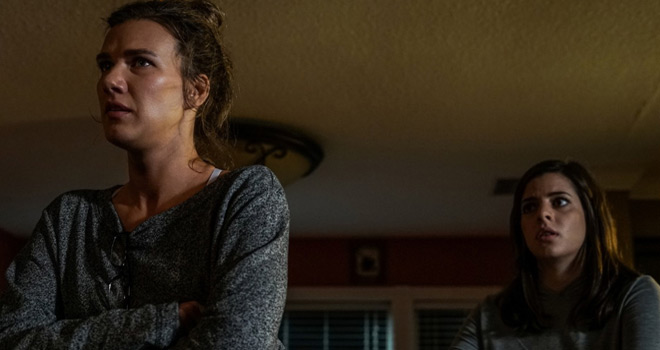
Not only that, but director Giorgio Serafini has precisely zero new ideas. Even his last minute plot ”inversion” is a predictable staple of the genre. Without giving too much away, a variation of this reveal is used in almost every home invasion flick (see the infinitely superior You’re Next or Better Watch Out for further reference), so somehow the twists and turns here are also by-the-numbers!
Worse still, there is a pervasive attitude of seediness that clings to the film throughout, specifically in relation to the (exclusively-female) victims. The camera is constantly ogling them, even when they are in a states of severe emotional distress/ physical peril, and they take their clothes off at seemingly random intervals, as if they’re trying to meet a quota or something.
Honestly, it’s telling that this gawking continues after the aforementioned assault, because the sleaziness of this film truly knows no bounds. How anyone could derive titillation from the sight of naked flesh AFTER already giving us a rape scene is truly beyond me, but apparently Serafini thought he’d give it the old college try.
Speaking of that churlish, needless rape sequence, boy is it a doozy! Overlong, uncomfortable and shamelessly exploitative, its only purpose in the film is to aggravate and disturb, which is pretty shitty when you think about it. It has no narrative justification for existing, other than to be used as a base shock-tactic. The heroines could have just as easily been under threat by armed killers or burglars and it wouldn’t have made an iota of difference. The only reason the filmmakers opted to go with rape is because that’s more ”extreme” and attention-grabbing.
Did I mention that the whole ordeal is presented as a montage too? Just to make it more untenable and crass.
Anyone who knows me personally will testify that I am not easily offended or upset and that I have seen FAR worse things than The Executioners before. So it’s not that I’m overly fragile or sensitive, nor do I automatically have a problem with rape appearing in films.
I just think it should have a reason for being there. Which is what I found so objectionable about this film. It went nowhere with its nastiness, there was nothing else to it besides endless misery. It was like having someone poking at you with a stick, repeatedly asking ”Are you shocked yet? Are you shocked yet?”
Also aren’t these rape-revenge narratives supposed to focus on the eventual retribution and payback? You know, the part of the story that’s actually cathartic and exciting for the audience? Take I Spit on Your Grave for example. That film dedicates significantly more time to showing the villains getting their, arguably even more brutal, comeuppance. By contrast, The Executioners kind of just shies away from all that stuff and is curiously hesitant to show us the perpetrators getting what they deserve. Why unflinchingly depict the suffering of the women like that, but then go so easy on the bad guys? It doesn’t make any sense!
There’s truly nothing positive that I can say about this film. The closest I can get to a compliment is that it successfully elicited a visceral reaction from me, but even then, that response was one of vitriol twinned with boredom.
Whilst it is indeed true that talented filmmakers like David Fincher and Martin Scorsese have made a name for themselves by producing provocative and twisted work, there was crucially always some substance to back up their edge. It takes real skill to do what they do, to keep people watching in-spite of the grime. Alas, Giorgio Serafini does not have that skill, so he comes across less like a dangerous maverick and more like a desperate try-hard with nothing to say.
Review | Dead List
If you type the words “Dead List” into Google, then you will be immediately confronted with a terrifying portrait of online culture. Granted, the same could be said for almost any two word combination on the internet. After all, there’s plenty of stuff out there to make you question our worth as a species, like revenge porn, malware viruses, Logan Paul videos and those articles where you have to click on a new page every 50 fucking words. Still, even in the festering cesspit of depravity that is the world wide web,‘’Dead List’’ manages to conjure up some uniquely depressing results.
For context, there seems to be a worrying abundance of blogs dedicated to forecasting which elderly celebrities will be the next to expire. Each of these sites is repulsive in its own right, but The Death List manages to stand out amongst the bunch, by keeping a running tally of their accurate predictions. They even go as far as to proudly display their score out-of-50 right right at the top of the page, just next to the eminently classy tagline; ‘’on today, gone tomorrow’’. Oh and they have a tacky merchandise store where you can buy their official underwear too. Nice!
Now as far as I’m concerned, no film should have its SEO comprised by a website that features headlines like ‘’No More Squawking for Hawking’’ and ‘’Hef in Hell?!’’ So in that sense, I feel inclined to be generous to Dead List, because no matter how shoddily made it is, it doesn’t deserve to be buried beneath all of this decadent slime. It makes me feel bad for it. Indeed, by virtue of not being a ghoulish mortality aggregate, it should be ranked higher in search engines results.
Sure, the camera work is ugly and the colour grading will be instantly off-putting to anyone with eyes. And yes, the production values are consistently appalling, the acting is at times embarrassing and the script is full of accidentally hilarious moments (e.g. ‘’There’s not enough space in this 5-seater to fit 4 people. Sorry you’re gonna have to get in the trunk!’’)
But beneath this scrappy, amateurish surface is an anthology rife with creative vigour and affectionate direction. For this very reason, I can honestly say that I found Dead List to be strangely charming and endearing, as it’s blatantly a misguided labour of love. Each of the film’s discrete chapters has something worth recommending in it, be it an interesting, if not particularly well realised concept, an inventive, if not particularly frightening scare, or just some fascinatingly inept decisions.
Even the lamest sequence, a silly, Drag Me to Hell riff with a demonic hag, offers up plenty of unintentional amusement. Which is still amusement. Most of the laughs stem from a ludicrously hammy performance, courtesy of Susan Stangl, who plays the cackling witch with such demented relish, that she begins to resemble a Monty Python character. Every single moment she is on screen is glorious, as she comically presses her face against windows, manically bulges her eyes and generally overacts to a cartoonist degree.
Curiously enough, not all of the highlights are of the so-bad-its good variety. As with any anthology, this is of course a mixed-bag, but what’s striking is how much the episodes differ in quality. Whilst some are enjoyably terrible, others are just legitimately enjoyable! For instance, a protracted sequence with a monstrous clown (obviously riding on the coattails of It) has some surprisingly novel ideas, such as balloon art that doubles up as a voodoo doll and a sentient chain of magic handkerchiefs that act like a snake.
The framing device that links together all of the disparate segments is also fairly clever. Essentially, a struggling actor is driving home following a disastrous audition, when a cryptic book mysteriously lands on the roof of his car. He takes the artefact home, with the intention of selling it online, only for his roommate (who is inexplicably schooled in the dark arts) to interject, explaining that the book can be used to sentence people to death by way of a mystical force. All you have to do is scribble down the target’s name and then let the eldritch horrors do the rest.
Tempted by this offer, our protagonist decides to eliminate his competition and writes down the names of all his acting buddies, so that they can never steal a role from him again. Each chapter then presents the fallout of this decision, with the chosen individuals being menaced by a different threat. Oh and to spice things up, it’s all presented out of sequence and with overlapping chronology, kind of like Pulp Fiction.
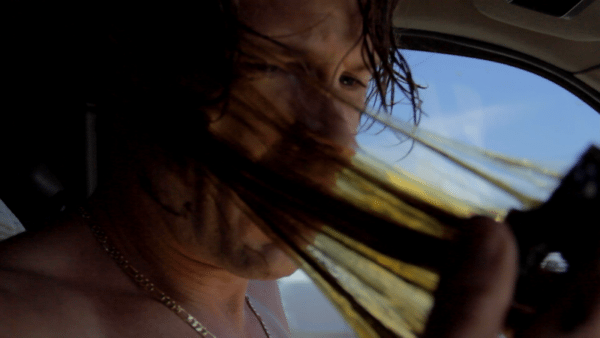
This is a relatively strong premise; think Death Note by way of Kill Your Friends. What works about it is that the vague nature of the malevolent force allows the filmmakers to change things up at any given time, without having to worry about how it all fits into the larger scheme of things. As a result, one minute we might be treated to a clunky race relations parable, the next we’re transported into a pulpy body horror movie.
In this regard, the overarching conceit of ‘’write down a name and then something bad will happen’’ is very liberating and stops the movie from ever falling into a repetitive rut. Because the book seemingly has an unlimited scope for what it can do, the filmmakers are free to transition between various different tones and sub-genres of horror, whilst still maintaining the sense of narrative progression that you would get with a traditional film. It’s the best of both worlds really; preserving the anything-goes sensibility of an anthology, but also facilitating a more focused narrative.
All in all, Dead List might feel like a glorified home-movie, but it is consistently fun. Sometimes it manages to hold your attention by making you laugh at it (thanks to its DIY makeup effects and wonky performances) but this is often balanced out by moments that show genuine promise and talent. Either way it’s never boring, which is more than I can say for a lot of straight to VOD releases.
Support Us!
Our Editing Software: https://amzn.to/2qfVbpl
Amazon: https://amzn.to/2JoqV4p
These links are affiliate links – by clicking them we will receive a small commission at no cost to you.
Reel Opinions is a UK based film review group that covers just about anything. From reviews of terrible movies to interviews with casts and directors Reel Opinions covers everything we can be bothered to make.
Review | Unsane
Steven Soderbergh’s psychological thriller, shot entirely on iphone, is well written, well refined, and clench inducing.
While it’s iphone-quality may turn some off, Soderberg utilizes the camera’s wide angle and deep focus to fully play into it’s characters insanity and the 90’s pulpy TV show feel of the feature. It may look cheap, but it never seems like a student film, and won’t be remembered as another “film shot on iphone”.
Review | Annihilation
Harrison steps into the shimmer to review Alex Garland’s ambitious adaption of Annihilation.
Review | The Cloverfield Paradox
Netflix manages to prove it’s revolutionizing cinema by buying it’s unwanted mess and hauking it. This is a mess of a film that was dead in the water until Netflix plunged it’s grimy hands in and tried to force it back into existence, while slapping just enough of a thin layer of Cloverfield to peddle it and turn a profit.
It is bad. It is stupid. It has damaged Netlflix’s reputation and they deserve it.
